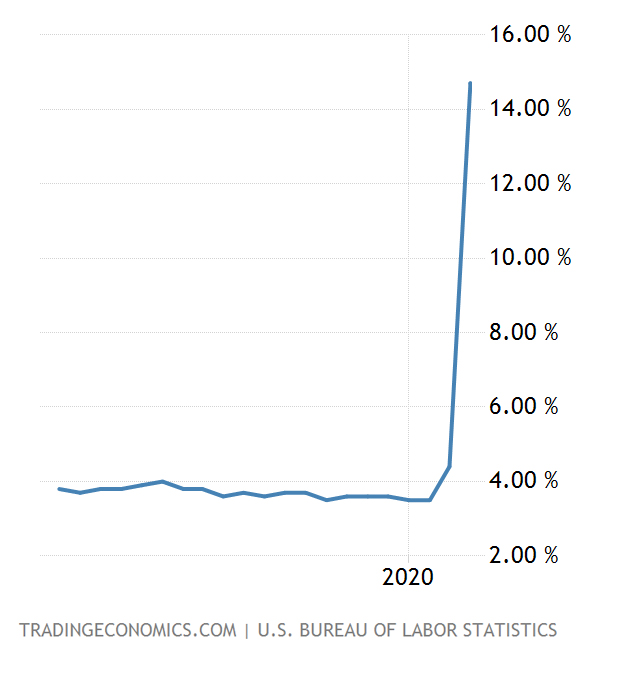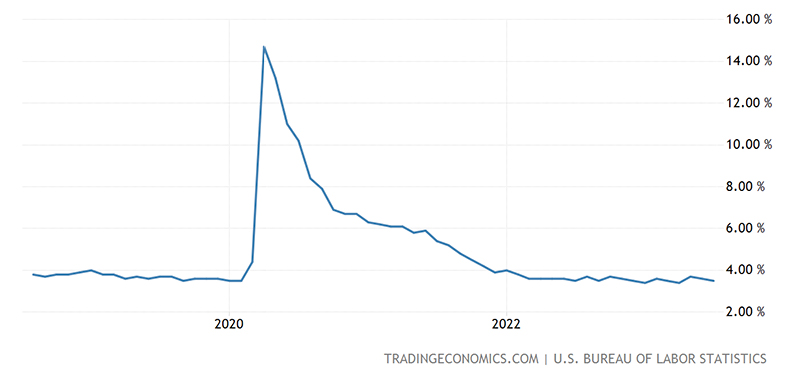Volcanoes are erupting in The Philippines, but on-fire Australia received some welcome rain. The Iran war cries have been called off and The Donald’s military powers are about to be hamstrung by the Senate. Meanwhile, his impeachment trial is starting, and we’re all on Twitter for a front-row seat.
What Could Go Right? It’s a workers’ world
In labor vs. capital, the one with leverage has switched for the first time in a long time.
This is our weekly newsletter, What Could Go Right? Sign up here to receive it in your inbox every Thursday at 5am ET. You can read past issues here.
It’s a workers’ world
In April 2021 The Economist ran a special section called “Riding high in a workers’ world” that I found as thrilling as economics writing gets.
“A reversal of the primacy of capital over labor beckons—and it will come sooner than you think,” predicted the section’s introduction. If April 2021 seems to you like an odd time to forecast a golden age for workers, you wouldn’t be alone. You might remember the catastrophic effect the Covid-19 pandemic had on labor markets, when the unemployment rate in the United States skyrocketed to 15 percent:

But The Economist had spied an early trend of that unemployment rate dropping as precipitously as it rose. Fast forward to now. The unemployment rate in July was 3.5 percent, which is near a half-century low.

This reality is at odds with public perception. In polling done in August by The Economist/YouGov, six in ten Americans see unemployment as a “very or somewhat serious national problem.” And only one in three say the number of jobs is increasing, despite the fact that this has been the case every month since the economy began its recovery from the pandemic.
The Economist report from 2021 also pinpointed a political environment “friendlier to workers than it has been for decades,” mentioning a “surge in minimum wages” in high-income countries. That includes the US.
Again, fast forward to now. Low-wage workers are seeing wages that seemed far out of reach as recently as 2012, when Fight for $15 began advocating for a $15 federal minimum wage. While that remains at $7.25 per hour, hardly anyone is paid that anymore—only 68,000 people across the US in 2023, according to a new article in The New York Times.
Workers have so much leverage in the current labor market that while the fight for $15 did see some state wins, even those are less relevant than they once were. Wages are “increasingly untethered to the official minimum wage,” says the Times article, as businesses struggle to find workers and even poach them from one another. Their graph of how much most low-wage workers are making—the “10th percentile wage” below—in each state is fascinating:

Now, the caveats. While $10 per hour is better than $7.25, that kind of money does not exactly leave people swimming in riches, even in a low-cost state like Mississippi. And this tight labor market isn’t guaranteed to last, although whether the higher wages will stick depends upon whom you ask.
I don’t think most would worry about large corporations, but how is this affecting the small business side of things? So far, fledgling entrepreneurs have not been deterred, with new business application numbers remaining well above those pre-pandemic, according to figures released in early August by the US Census Bureau (chart on first page here). Those applications, says a small business report by Visa, are “highly likely to have staff and payroll capabilities still far above the 2019 average.”
Higher labor costs, though, are contributing to more challenging conditions for small businesses, the report goes on, along with rising interest rates and inflation—which is easing—as well as other factors.
This mix has actually produced a small bump in small business owners’ optimism, according to a report by the National Federation of Independent Business (NFIB)—although it’s still low, comparatively. NFIB’s Optimism Index is now at 91.9, which seems very optimistic until you learn that the 49-year average is 98. Small business owners are an optimistic bunch.
The rest of us are much less so. A common explanation as to why Americans are so gloomy about the economy is that inflation has eaten away at purchasing power, which is a fancy way of saying that $10 that buys you two sandwiches is much more useful than $10 that buys you one (unless you’re in my old city of New York, where I hear that $10 won’t even get you half of a sandwich these days).
I also think The Progress Network (TPN) Member Isaac Saul nailed it when he wrote in July that Americans’ negativity is due in large part to the ongoing sticker shock of daycare, housing, and healthcare. That is understandable.
To find ourselves in the workers’ world The Economist saw coming, though, with small businesses trucking onward and inflation trending downward for consumers and businesses alike, does indeed seem like something to be riding high about.
Quick hits
- Mozambique connected half a million people to clean tap water in their homes. We made a TikTok about it.
- This animation of Africa’s progress on infant mortality is making the rounds on Twitter this week. Would you like a deeper newsletter dive into that? Comment below or write to hello@theprogressnetwork.org.
Below in the links section, AI helps a stroke patient speak, psychedelics may help heal brain injuries, India lands on the moon, and more.
Progress, Please
(Found good news? Tweet at us @progressntwrk or email.)
Other good stuff in the news 🌕
Energy & Environment:
- Renewable energy investment hits record-breaking $358B | Bloomberg
- Pacific coral reef shows unprecedented increase in climate resistance | SciTechDaily
- Equinor opens world’s largest floating wind farm in Norway | Reuters
- How South Korea’s composting system became a model for the world | Los Angeles Times
- Geothermal energy: Are we entering a golden age? | DW
- Washington state on track to achieve 100% clean energy by 2045, leaders say | Fox 13 Seattle
- Steel is getting cleaner | The New York Times
- Zimbabwe sees recycling boom as waste picking becomes lucrative business | Mongabay
- Electric cars pass a crucial tipping point in 23 countries | Bloomberg
- Prehistoric bird once thought extinct returns to New Zealand wild | The Guardian
- Lifeline for endangered insect feared extinct | BBC
Public Health:
- Jerusalem doctors carry out revolutionary AR robotic spinal surgery | Jerusalem Post
- How psychedelic drugs help heal the brain from traumatic injury | National Geographic
- Young adults in the US are drinking less than in prior decades | Gallup
- Phone app helped students cut down on drinking, researchers say | The Guardian
- The world’s therapists are talking to Ukraine | Reasons to Be Cheerful
- HIV vaccine trial that could be ‘the last roll of the dice’ this decade is underway | CNN
- Telehealth bridges the mental health gap for older rural folks | Reasons to Be Cheerful
- A broad genetic test saved one newborn’s life. Research suggests it could help millions of others | AP
Science & Tech:
- AI helps a stroke patient speak again, a milestone for tech and neuroscience | The New York Times
- India lands a spacecraft near the moon’s south pole, a first for the world | AP
- A first look from NASA’s new air pollution satellite | The New York Times
- AI can predict which species are at risk of extinction if another species is removed from an ecosystem | Mongabay
- Can AI detect wildfires faster than humans? California is trying to find out | The New York Times
- Apple has finally relented on the ‘right to repair’ | The Atlantic
- The firms that want to test menstrual blood | BBC
- AI-discovered drugs will be for sale sooner than you think | Vox
- Scientists have finally decoded mysteries of the Y chromosome. Here’s why it matters | CNN
- Electrified cement could turn houses and roads into nearly limitless batteries | Science
- Smart contact lens battery charged by human tears | Interesting Engineering
- Coming soon: Airborne telemedicine | Axios
Politics & Policy:
- Victoria to halve gender pay gap in public service—and name 70% of new streets after women | The Guardian
- Automakers now have to comply with MA’s Right to Repair law | TechCrunch
- Underage influencers are protected by new Illinois law | NPR
- Montreal adds nine more car-free streets after ‘mind blowing’ success | The Energy Mix
- Queensland to kickstart organic waste collection with purchase of 1m household bins | The Guardian
- Bringing 13M more children into school: Lessons from Punjab | World Bank
- FEMA announces $2.5B in climate resilience funds | The Hill
TPN Member originals 🧠
(Who are our Members? Get to know them.)
- Is fixing democracy partisan? | Danielle Allen
- Kids, court, and climate change: A Montana court ruling changes the fight against climate change | Isaac Saul
- Talk to a stranger and be happier | Arthur C. Brooks
- Argentina’s economic dilemma—and ours | Matthew Yglesias
- The new old age | David Brooks
- C’mon, Republicans, this isn’t a ‘dark moment’ for an America ‘in decline’ | James Pethokoukis
Department of Ideas 💡
(A staff recommendation guaranteed to give your brain some food for thought.)
Yuval Noah Harari on human nature, intelligence, power, and conspiracies | Lex Fridman Podcast
Why we picked it: It’s packed with food for thought: Is intelligence overvalued? Is consciousness more important? Is suffering a mark of consciousness? Are stories living organisms? Do greater positive outcomes also inherently lead to greater negative ones? Could efforts to upgrade humans end up downgrading them? Is learning to manage boredom the way to peace? Listen and see what you think. —Brian Leli
Upcoming Events
- What is the state of surveillance? | The Progress Network | September 26
Until Next Time
BREAKING:100-year-old miracle lettuce discovered in Indiana. 😲


